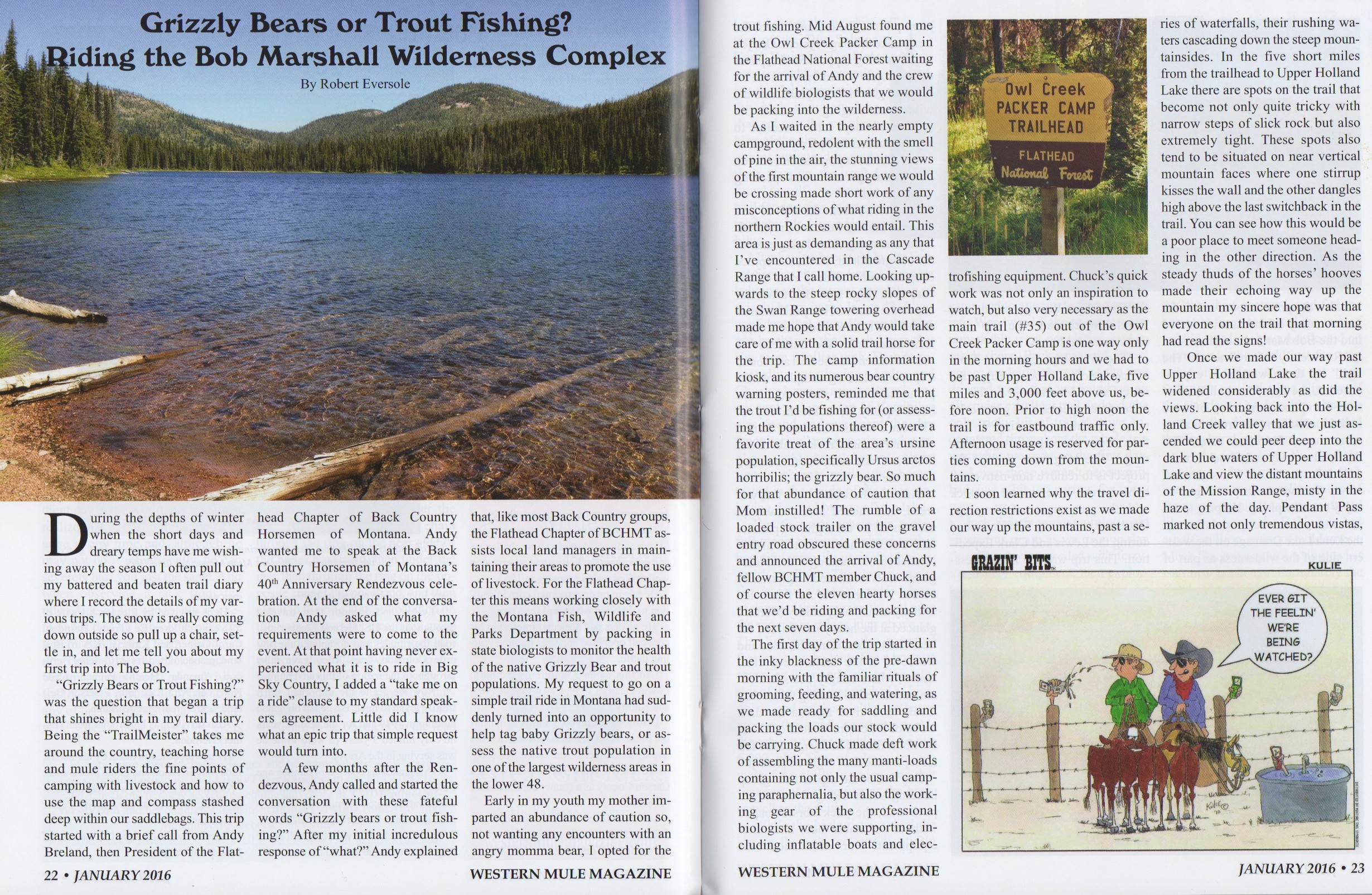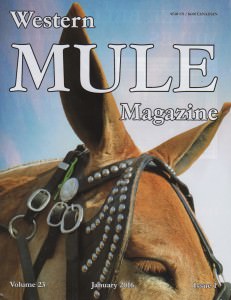 Grizzly Bears or Trout Fishing? – Riding the Bob Marshall Wilderness Complex.
Grizzly Bears or Trout Fishing? – Riding the Bob Marshall Wilderness Complex.
As Published in Western Mule Magazine – January 2016 edition
During the depths of winter when the short days and dreary temps have me wishing away the season I often pull out my battered and beaten trail diary where I record the details of my various trips. The snow is really coming down outside so pull up a chair, settle in, and let me tell you about my first trip into The Bob.
“Grizzly Bears or Trout Fishing?” was the question that began a trip that shines brightly in my trail diary. Being the “TrailMeister” takes me around the country, teaching horse and mule riders the fine points of camping with livestock and how to use the map and compass stashed deep within our saddlebags. This trip started with a brief call from Andy Breland, then President of the Flathead Chapter of Back Country Horsemen of Montana. Andy wanted me to speak at the Back Country Horsemen of Montana’s 40th Anniversary Rendezvous celebration. At the end of the conversation, Andy asked what my requirements were to come to the event. At that point having never experienced what it is to ride in Big Sky Country, I added a “take me on a ride” clause to my standard speaker’s agreement. Little did I know what an epic trip that simple request would turn into.
A few months after the Rendezvous, Andy called and started the conversation with these fateful words “Grizzly bears or trout fishing?” After my initial incredulous response of “what?” Andy explained that, like most Back Country groups, the Flathead Chapter of BCHMT assists local land managers in maintaining their areas to promote the use of livestock. For the Flathead Chapter, this means working closely with the Montana Fish, Wildlife and Parks Department by packing in state biologists to monitor the health of the native Grizzly Bear and trout populations. My request to go on a simple trail ride in Montana had suddenly turned into an opportunity to help tag baby Grizzly bears or assess the native trout population in one of the largest wilderness areas in the lower 48.
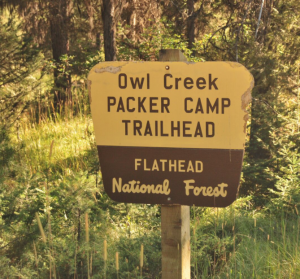 Early in my youth, my mother imparted an abundance of caution so, not wanting any encounters with an angry momma bear, I opted for the trout fishing. Mid- August found me at the Owl Creek Packer Camp in the Flathead National Forest waiting for the arrival of Andy and the crew of wildlife biologists that we would be packing into the wilderness.
Early in my youth, my mother imparted an abundance of caution so, not wanting any encounters with an angry momma bear, I opted for the trout fishing. Mid- August found me at the Owl Creek Packer Camp in the Flathead National Forest waiting for the arrival of Andy and the crew of wildlife biologists that we would be packing into the wilderness.
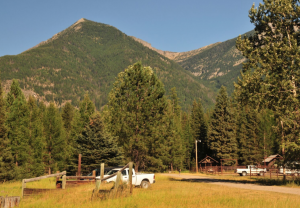 As I waited in the nearly empty campground, redolent with the smell of pine in the air, the stunning views of the first mountain range we would be crossing made short work of any misconceptions of what riding in the northern Rockies would entail. This area is just as demanding as any that I’ve encountered in the Cascade Range that I call home. Looking upwards to the steep rocky slopes of the Swan Range towering overhead made me hope that Andy would take care of me with a solid trail horse for the trip. The camp information kiosk and its numerous bear country warning posters reminded me that the trout I’d be fishing for (or assessing the populations thereof) were a favorite treat of the areas ursine population, specifically Ursus arctos horribilis; the grizzly bear. So much for that abundance of caution that Mom instilled!
As I waited in the nearly empty campground, redolent with the smell of pine in the air, the stunning views of the first mountain range we would be crossing made short work of any misconceptions of what riding in the northern Rockies would entail. This area is just as demanding as any that I’ve encountered in the Cascade Range that I call home. Looking upwards to the steep rocky slopes of the Swan Range towering overhead made me hope that Andy would take care of me with a solid trail horse for the trip. The camp information kiosk and its numerous bear country warning posters reminded me that the trout I’d be fishing for (or assessing the populations thereof) were a favorite treat of the areas ursine population, specifically Ursus arctos horribilis; the grizzly bear. So much for that abundance of caution that Mom instilled!
The rumble of a loaded stock trailer on the gravel entry road obscured these concerns and announced the arrival of Andy, fellow BCHMT member Chuck, and of course the eleven hearty horses that we’d be riding and packing for the next 7 days.
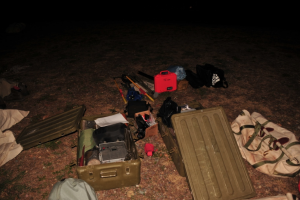 The first day of the trip started in the inky blackness of the predawn morning with the familiar rituals of grooming, feeding, and watering, as we made ready for saddling and packing the loads our stock would be carrying. Chuck made deft work of assembling the many manti-loads containing not only the usual camping paraphernalia but also the working gear of the professional biologists we were
The first day of the trip started in the inky blackness of the predawn morning with the familiar rituals of grooming, feeding, and watering, as we made ready for saddling and packing the loads our stock would be carrying. Chuck made deft work of assembling the many manti-loads containing not only the usual camping paraphernalia but also the working gear of the professional biologists we were 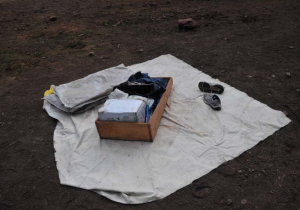 supporting, including inflatable boats and electrofishing equipment. Chuck’s quick work was not only an inspiration to watch, but also very necessary as the main trail (#35) out of the Owl Creek Packer Camp is one way only in the morning hours and we had to be past Upper Holland Lake, five miles and 3,000 feet above us, before noon. Prior to high noon the trail is for eastbound traffic only. Afternoon usage is reserved for parties coming down from the mountains.
supporting, including inflatable boats and electrofishing equipment. Chuck’s quick work was not only an inspiration to watch, but also very necessary as the main trail (#35) out of the Owl Creek Packer Camp is one way only in the morning hours and we had to be past Upper Holland Lake, five miles and 3,000 feet above us, before noon. Prior to high noon the trail is for eastbound traffic only. Afternoon usage is reserved for parties coming down from the mountains.
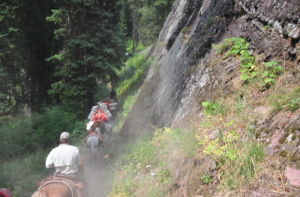 I soon learned why the travel direction restrictions exist as we made our way up the mountains, past a series of waterfalls, their rushing waters cascading down the steep mountainsides. In the five short miles from the trailhead to Upper Holland Lake there are spots on the trail that become not only quite tricky with narrow steps of slick rock but also extremely tight. These spots also tend to be situated on near vertical mountain faces where one stirrup kisses the wall and the other dangles high above the last switchback in the trail. You can see how this would be a poor place to meet someone heading in the other direction. As the steady thuds of the horses’ hooves made their echoing way up the mountain my sincere hope was that everyone on the trail that morning had read the signs!
I soon learned why the travel direction restrictions exist as we made our way up the mountains, past a series of waterfalls, their rushing waters cascading down the steep mountainsides. In the five short miles from the trailhead to Upper Holland Lake there are spots on the trail that become not only quite tricky with narrow steps of slick rock but also extremely tight. These spots also tend to be situated on near vertical mountain faces where one stirrup kisses the wall and the other dangles high above the last switchback in the trail. You can see how this would be a poor place to meet someone heading in the other direction. As the steady thuds of the horses’ hooves made their echoing way up the mountain my sincere hope was that everyone on the trail that morning had read the signs!
Once we made our way past Upper Holland Lake the trail widened considerably as did the views. Looking back into the Holland Creek valley that we just ascended we could peer deep into the dark blue waters of Upper Holland Lake and view the distant mountains of the Mission Range, misty in the haze of the day. Pendant Pass marked not only tremendous vistas but also the point where we left the front country behind us and entered into the Bob Marshall Wilderness.
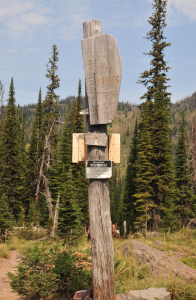 Reverently referred to as “The Bob” by those who have experienced it, the Bob Marshall Wilderness Complex is made up of three individual wilderness areas totaling more than 1.5 million acres. The Bob is also Andy and Chuck’s backyard. It is spectacular. The sights and views that we were privileged to enjoy were inspiring. Helping to assess the native trout populations in the Lena Lake Drainage on the western side of the wilderness as part of the South Fork Westslope Cutthroat Trout Project made the trip even more memorable.
Reverently referred to as “The Bob” by those who have experienced it, the Bob Marshall Wilderness Complex is made up of three individual wilderness areas totaling more than 1.5 million acres. The Bob is also Andy and Chuck’s backyard. It is spectacular. The sights and views that we were privileged to enjoy were inspiring. Helping to assess the native trout populations in the Lena Lake Drainage on the western side of the wilderness as part of the South Fork Westslope Cutthroat Trout Project made the trip even more memorable.
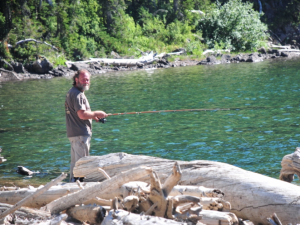 The Westslope Cutthroat Trout (Oncorhynchus clarki lewisi), is the state fish of Montana. It is also an endangered species with genetically pure populations existing in less than three percent of its historic range. The long-term goal of the project is to remove non-native and hybrid trout species and re-stock with the pure strains of Westslope Cutthroat that were first described during the Lewis and Clark Expedition. This trip was the final assessment prior to the reclamation of the Lena Lake drainage system. Our job as the packing support for this phase of the project was to transport the biologists’ gear and equipment into the wilderness staging area and out again seven days later. Needless to say, the Packers had plenty of time to sample the trout population between the initial pack-in and packing everyone out.
The Westslope Cutthroat Trout (Oncorhynchus clarki lewisi), is the state fish of Montana. It is also an endangered species with genetically pure populations existing in less than three percent of its historic range. The long-term goal of the project is to remove non-native and hybrid trout species and re-stock with the pure strains of Westslope Cutthroat that were first described during the Lewis and Clark Expedition. This trip was the final assessment prior to the reclamation of the Lena Lake drainage system. Our job as the packing support for this phase of the project was to transport the biologists’ gear and equipment into the wilderness staging area and out again seven days later. Needless to say, the Packers had plenty of time to sample the trout population between the initial pack-in and packing everyone out.
The views from the trail as you descend into the Pendant Creek Valley are amazing. The dark greens of the old growth fir, larch, and spruce contrast with the deep reds of the bare rock ridge tops that tower far above the heads of the pack animals ahead and behind you. About 14 miles from the trailhead we rounded a bend in the trail and found a spacious clearing complete with a picturesque cabin that would have been equally at home in any of Thoreau’s works. The Guard Station cabin at Pendant Creek would be our home and base camp for the remainder of the trip.
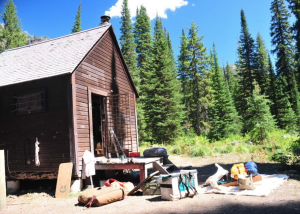 After the livestock were fed, watered, and tucked safely away in their corral for the night, we Packers laid out our heavy cotton manti-cloth bedrolls amongst the biologists’ tents scattered haphazardly across the meadow. As I crawled into my remarkably comfy bedroll I glanced at the heavy iron bars of the bear shutters covering the door and windows of the cabin. Deep claw marks, where hungry bears had examined the cabin looking for an easy meal, were vivid against the dark wood of the cabin. Visions of Ursus horribilis danced in my mind as I fell asleep on the first night of the trip.
After the livestock were fed, watered, and tucked safely away in their corral for the night, we Packers laid out our heavy cotton manti-cloth bedrolls amongst the biologists’ tents scattered haphazardly across the meadow. As I crawled into my remarkably comfy bedroll I glanced at the heavy iron bars of the bear shutters covering the door and windows of the cabin. Deep claw marks, where hungry bears had examined the cabin looking for an easy meal, were vivid against the dark wood of the cabin. Visions of Ursus horribilis danced in my mind as I fell asleep on the first night of the trip.
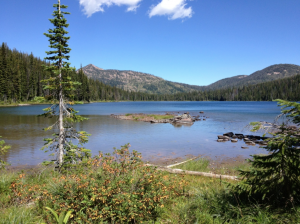 Day two of the trip had our group heading south along a well-worn pack trail, the pack horses loaded with an inflatable boat and other equipment. Our destination was Lena Lake at the headwaters of the Big Salmon Creek Drainage. The biologists would be examining the fish population of this high mountain lake that echoes the cerulean blue of the sky above. As our mounts steadily made their way up the trail I found myself scanning the trail for any sign of tracks made by Mr. Ursus Horribilus.
Day two of the trip had our group heading south along a well-worn pack trail, the pack horses loaded with an inflatable boat and other equipment. Our destination was Lena Lake at the headwaters of the Big Salmon Creek Drainage. The biologists would be examining the fish population of this high mountain lake that echoes the cerulean blue of the sky above. As our mounts steadily made their way up the trail I found myself scanning the trail for any sign of tracks made by Mr. Ursus Horribilus.
After having been told by the Forest Service that the Lena Lake area is home to the largest population of grizzly bears in the lower 48, I was confident that soon I’d see the bigger brother to the black bears that I’m more familiar with. Despite repeatedly questioning Andy and Chuck whenever a suspect track was encountered, no sign of Horribilus was found and we spent the day “monitoring” trout species and sampling wild huckleberries along Lena’s shores while the horses rested in the shade of the trees, enjoying the cool breeze off the lake.
Day four was ushered in with a full moon blazing overhead with a beautiful intensity unrivaled by any garish city lights. The clear night sky slowly gave way to the reddish hues of dawn as the sun silently slid over the mountain ridges high above us. The lightening sky also revealed frost coating the tents like a layer of sparkling diamonds. 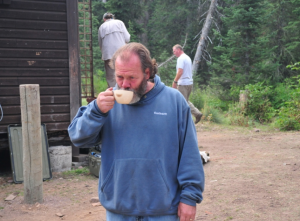
Soon the interior of the cabin was packed as biologists and packers alike gathered around the small wood stove. Although it was the middle of August 6,000 plus feet of elevation can make for a chilly morning, and that first cup of coffee warms the body as well as the soul.
While the biologists studied the stream flow characteristics of Big Salmon Creek the Packers headed downstream to find our way into the Necklace Lakes that lay north of camp and to attempt to find our way into Woodward Lake to sample the remarkable trout population said to reside there. Pack saws and elbow grease made quick work of the few downed trees that we found, on an otherwise excellent trail. Indeed the only tricky bit of trail that we encountered throughout the whole trip was what we rode on the first day. And even those weren’t necessarily bad, just a bit too narrow for company.
Jack Frost’s nippy morning cold greeted us again as we rose on day five. The day proceeded with ferrying fishery equipment, then exploring the myriad of trails on horseback. Shortly after the sun passed its apex during the early afternoon the smell of smoke wafted by on the breeze. Forest wildfires are serious business in The Bob as attested by the large pile of reflective metallic tarps that fire crews had staged near the cabin in case of fire. Fortunately, the smoke was from a distant burn and we were not in any immediate danger. Nonetheless over dinner that night it was decided to depart the following morning as all of the objectives of the trip had been fulfilled, in large part due to the presence of Andy and Chuck and their pack stock.
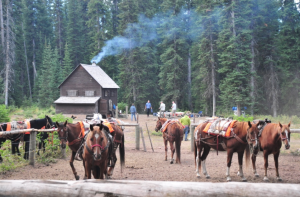 Breaking camp is always done with some melancholy and my last day in The Bob was no exception. As I brushed, watered, and fed the horses before we started the task of saddling and packing, I reflected on returning to the world just 14 miles and a few days in my past. Still with me is the last glimpse of the Pendant Creek cabin slipping away in the distance as we rounded the first bend in the trail.
Breaking camp is always done with some melancholy and my last day in The Bob was no exception. As I brushed, watered, and fed the horses before we started the task of saddling and packing, I reflected on returning to the world just 14 miles and a few days in my past. Still with me is the last glimpse of the Pendant Creek cabin slipping away in the distance as we rounded the first bend in the trail.
In the years since I’ve had the privilege of returning to the Bob many times and sampling more of the area’s iconic locations scattered like gems across the Bob’s one and a half million acres of wilderness. Much like potato chips a single visit isn’t nearly enough. Fortunately, the Bob holds a lifetime of possibilities.
As always for more information about the various trailheads that we’ve read about and how to get into them please visit www.TrailMeister.com the largest horse trail and camping area guide in the world.


